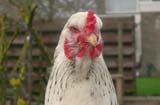Bird Flu
Just the Facts
Bird flu--or avian influenza--is a viral disease affecting the respiratory, digestive and/or nervous system of many species of birds. Avian influenza virus infection can occur in most, if not all, species of birds, both domestic and wild. Influenza viruses vary widely in their ability to cause disease and their ability to spread among birds. Wild species of birds usually do not develop clinical disease, but some influenza viruses cause severe illness or death in chickens, turkeys, and guinea fowl.
Bird Flu Facts
Infected birds shed flu virus in their saliva, nasal secretions, and feces. Susceptible birds become infected when they have contact with contaminated excretions or surfaces that are contaminated with excretions.
It is believed that most cases of bird flu infection in humans have resulted from contact with infected poultry or contaminated surfaces.
There is no evidence to indicate that Avian Influenza is transmitted vertically, from hen into the egg. Chicks are not born with avian influenza. Many educational projects, like the 4-H embryology project, begin with clean eggs from a known supplier.
Poultry originating from areas of the world where there are strains of the disease are prohibited from entering the United States, and all commercial poultry entering Florida from other states are required to have a permit for entry and must originate from influenza-free flocks.
The Florida Department of Agriculture, Division of Animal Industry has thirty-five authorized agents trained to collect samples, and testing to determine the presence of the disease is being conducted at two of the department's animal health laboratories. Samples are regularly collected from backyard flocks and commercial poultry breeding flocks, and the state has a voluntary surveillance and testing program.
Veterinarians, veterinary laboratories, and those working with birds in Florida are required to report suspected cases of avian influenza to the Commissioner of the Florida Department of Agriculture and Consumer Services. Quarantine and other emergency plans are in place to eradicate such a disease as quickly as possible if bird flu is detected.
Compiled from:
Avian Diseases Transmissible to Humans (PS23) by Jacqueline P. Jacob, Jack M. Gaskin, Henry R. Wilson, and F. Ben Mather. Published by: Animal Science Department (rev. 6/2003).
Avian Influenza in Poultry (PS38) by J. P. Jacob, G.D. Butcher, F. B. Mather, and R.D. Miles. Published by: Animal Science Department (rev. 6/2003).
What Are the Risks of Contracting Diseases Associated with Chickens? (ENY724) by Roxanne Rutledge Connelly, Christopher Mores and Amy H. Simonne. Published by: Entomology and Nematology Department (9/2005).

Related Sites
- Avian Influenza--FDACS
- Avian Influenza--World Health Organization
- Avian Influenza (Bird Flu)--CDC
- Bird Flu--Medline Plus
- Bird Flu (Avian Influenza)--U.S. Department of State
- Bird Flu Information--National Agricultural Library
- Emerging Pathogens Institute
- Pandemic Flu--U.S. Department of Health and Human Services

